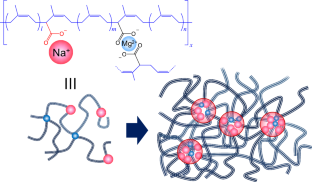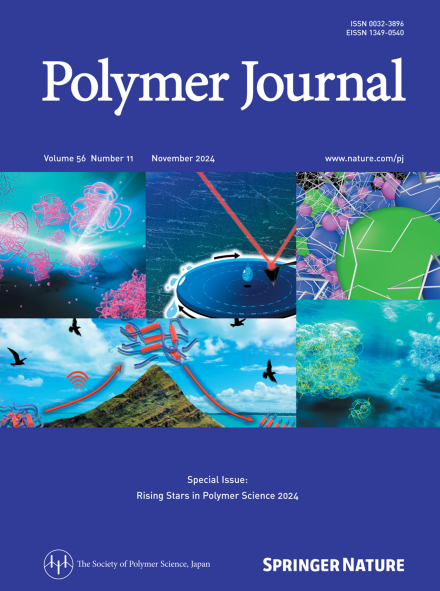Mg2+ 比率对与 Na+ 和 Mg2+ 共同中和的聚异戊二烯离聚物的机械性能和自愈合性能的影响
IF 2.7
4区 化学
Q3 POLYMER SCIENCE
引用次数: 0
摘要
研究了二价阳离子(Mg2+)和一价阳离子(Na+)的比例对与 Na+ 和 Mg2+ 共中性的聚异戊二烯(PI)离聚物的机械和自愈性能的影响。羧酸钠通过静电作用连接聚合物链,而羧酸镁则通过离子键更牢固地连接聚合物链。因此,Mg2+ 在很大程度上强化了 PI 离子聚合物。然而,我们发现 PI 离聚物的机械性能并没有随着 Mg2+ 的比例变化而成正比。当 Mg2+ 的比例超过 25% 时,离子聚合物得到明显增强,在这种情况下,通过 Mg2+ 在网络中的连接在整个材料中非常普遍。与此同时,PI 离子聚合物的自愈合能力被破坏。本文章由计算机程序翻译,如有差异,请以英文原文为准。


Effect of the Mg2+ ratio on the mechanical and self-healing properties of polyisoprene ionomers co-neutralized with Na+ and Mg2+
The effect of the ratio of divalent (Mg2+) to monovalent (Na+) cations on the mechanical and self-healing properties of polyisoprene (PI) ionomers co-neutralized with Na+ and Mg2+ was studied. Sodium carboxylates link polymer chains via electrostatic interactions, while magnesium carboxylates more strongly link polymer chains via ionic bonds. Therefore, Mg2+ considerably reinforces the PI ionomer. However, we found that the mechanical properties of the PI ionomers did not change proportionally to the ratio of Mg2+. The ionomer was significantly reinforced at over 25% of the Mg2+ ratio, where linkage via Mg2+ in the network was prevalent throughout the material. At the same time, the self-healing of the PI ionomer was disrupted. The morphology and physical properties of polyisoprene ionomers co-neutralized with Na+ and Mg2+ in different ratios have been studied. The mechanical and self-healing properties of the ionomer were reinforced and disturbed, respectively, at over 25 % of the Mg2+ ratio, where linkage via Mg2+ in the network is pervasive throughout the material.
求助全文
通过发布文献求助,成功后即可免费获取论文全文。
去求助
来源期刊

Polymer Journal
化学-高分子科学
CiteScore
5.60
自引率
7.10%
发文量
131
审稿时长
2.5 months
期刊介绍:
Polymer Journal promotes research from all aspects of polymer science from anywhere in the world and aims to provide an integrated platform for scientific communication that assists the advancement of polymer science and related fields. The journal publishes Original Articles, Notes, Short Communications and Reviews.
Subject areas and topics of particular interest within the journal''s scope include, but are not limited to, those listed below:
Polymer synthesis and reactions
Polymer structures
Physical properties of polymers
Polymer surface and interfaces
Functional polymers
Supramolecular polymers
Self-assembled materials
Biopolymers and bio-related polymer materials
Polymer engineering.
 求助内容:
求助内容: 应助结果提醒方式:
应助结果提醒方式:


